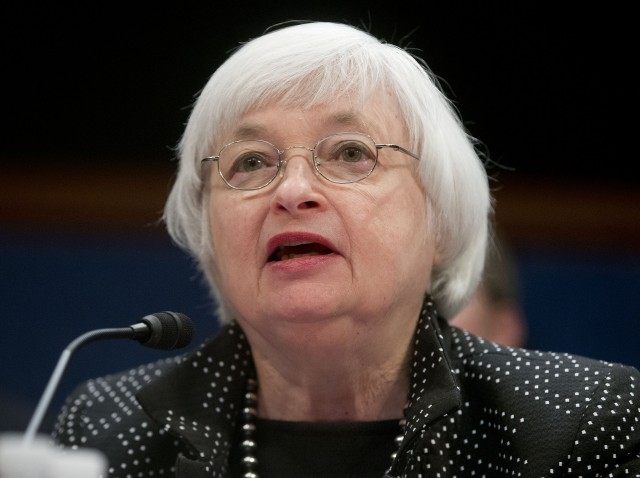Federal Reserve Chairwoman Janet Yellen recently joined the rising chorus of economists and former Fed officials warning about the risks of irrational exuberance by bond and stock investors paying bubble-inflated prices. Conspicuously silent about the risks of stock investing over the last 6 years, Yellen’s comments quickly tanked the bond market. But with the NASDAQ tech-heavy index up 500% since the bottom of the last crash, Yellen seems to be warning this bubble could pop.
Yale Nobel Prize-winning economist Robert J. Shiller has published three editions of his iconic book: Irrational Exuberance. On March 15, 2000, as prices of tech heavy NASDAQ were peaking just before an 76% crash, he warned that the stock market “was in a speculative bubble, not grounded in sensible economic fundamentals.”
Exactly five years later, as residential real estate was peaking just before a 35% national crash, Schiller published a second edition of Irrational Exuberance warning that housing prices were “in a speculative bubble, not grounded in sensible economic fundamentals.” On January 29, 2015, Schiller published a third edition of Irrational Exuberance, warning that “the bursting of the speculative bubbles that led to the 2007-9 world financial crisis” has again “accelerated since the crisis” for “valuations in the stock and bond markets.”
Yellen not only knows Robert Schiller as a distinguished academic economist, but her distinguished academic economist husband George Akerlof and Robert Schiller also co-wrote Animal Spirits in 2009. The tome reasserted the necessity of an active government role in economic policymaking by resurrecting the idea of “animal spirits,” a term John Maynard Keynes used to describe the gloom and despondence that led to the Great Depression, and the changing psychology that accompanied recovery. The book influenced Yellen to support an ultra-easy monetary policy and an ultra-low interest rate environment.
Yellen made her bearish comments during a high-visibility public interview with International Monetary Fund Managing Director Christine Lagarde at an IMF seminar at the IMF headquarters in Washington DC on May 6. Ms. Lagarde asked the U.S. central bank chief about the possibility that the Fed’s rock-bottom interest-rate policy is leading to bubbles in financial markets. Yellen reportedly answered:
“I would highlight that equity-market valuations at this point generally are quite high,” Ms. Yellen said. “Not so high when you compare returns on equity to returns on safe assets like bonds, which are also very low, but there are potential dangers there.”
Bloomberg News reported this week in “Bond-Market Crash Has Wall Street Divided on What’s Next” that the global bond selloff following Yellen’s comments has “set investors on edge.” Some analysts said the worst of the selling rout might be over after weeks of pain. But the investment banking firm of Goldman Sachs warned that government debt is still expensive, despite the crash in prices sending bond yields soaring.
Since Yellen’s comments, the stock markets have been stable. But the bond market crash brought back memories of the grim dot-com technology stock crash that started in March of 2000 and did not bottom until the NASDAQ was down 76% on October 9, 2002.
The current valuation for all the stocks on the NASDAQ index is about $9.2 trillion. That compares to almost $20 trillion at the 2000 market top. But a big part of the lower valuation is due to a few big companies’ stock prices being crushed. AOL saw its stock value plunge from $226 billion to about $20 billion in the dot-com crash, for example. Just last week, Verizon offered to buy what is left of AOL from Time Warner for only $4.4 billion.
Wall Street analysts use “metrics” to try to justify the current stock market prices as reasonable, including: 1) During the dot-com boom, investors were willing to pay 152 times companies’ earnings, versus an industry average of 19.1 times today; and 2) during the dot-com boom, investors were willing to pay 6.7 times companies’ book value versus 3.9 times today. But those lower “multiples” are still highly inflated compared to valuations over the last 100 years.
Today’s stock market bubble may not be as “flamboyant” as the 2000 dot-com Crash or the 2007 subprime real estate crash. But that is only because there is no standard definition of what a “crash” is. After a bubble bursts, everyone claims to have seen it coming.
Fed Chair Yellen knows that Robert Shiller has documented that the financial conditions most likely to lead to asset bubbles are the rear combination of an ultra-easy monetary policy and an ultra-low interest rate environment. Having been personally responsible for setting the monetary policy that created both conditions, Yellen seems to have given investors a warning that this stock market bubble may soon burst–like those before it.

COMMENTS
Please let us know if you're having issues with commenting.